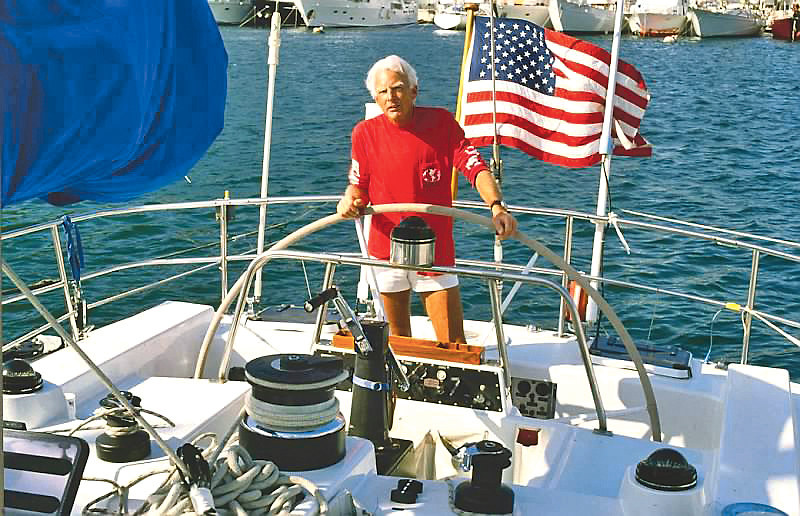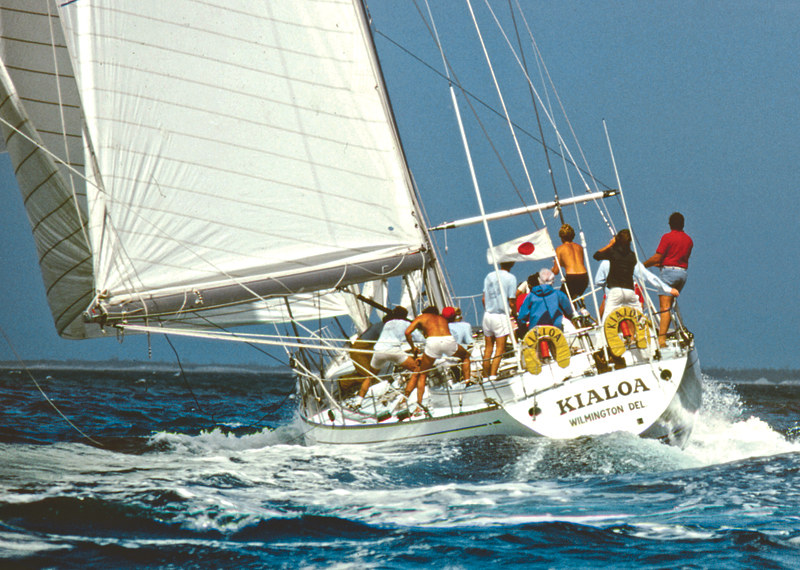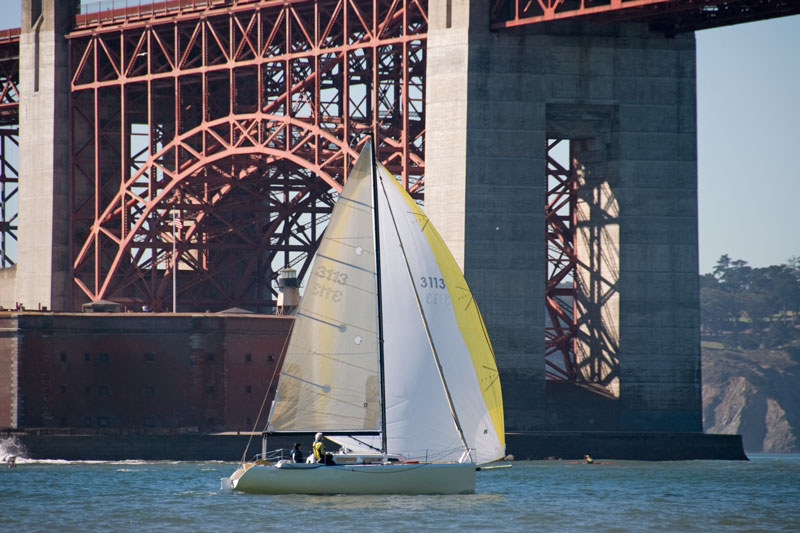
Eight Bells for Jim Kilroy

One of the true titans of competitive sailing passed over the bar yesterday: ‘Gentleman Jim’ Kilroy was 94.
Having campaigned a succession of five splendid racing yachts — all named Kialoa — and garnered frequent victories, Kilroy was a dominant influence within the international sailing community for decades. In fact, he is regarded as a pied piper of sorts, having inspired many other yacht owners to follow his lead in competing at prestigious regattas around the world. The sport of sailing would not have been the same in recent decades, without his tireless enthusiasm and thirst for innovation.
Born in Alaska in 1922, Kilroy’s childhood memories included his mother transporting him, his brother and sister in a dogsled. The family moved to Southern California in 1927 (Jim was five). There his father left, leaving Jim’s mom to raise the family alone. When Jim was old enough he helped out by mowing lawns, delivering papers and working in a bike shop. He graduated high school a year ahead of the norm.
In 1940, Kilroy dropped out of UC Santa Barbara’s engineering program to work at Douglas Aircraft, which then built Navy dive bombers. In 1944, he joined the Army Air Corps, where he studied all facets of aerodynamics and airplane construction — and learned to fly.
After the war, having married and started a family, Kilroy delved into real estate, and eventually formed his own construction company in order to modify existing structures to meet the needs of the growing aeronautics/aerospace industry. Next, he started buying, selling and revamping industrial sites himself, or designing and building them from the ground up. He became a dominant figure in the SoCal commercial real estate industry.

Kilroy’s first exposure to sailing occurred at age 11, when he took a spin around Newport Harbor in a 12-ft Snowbird — he’d won the day trip to Newport by selling newspaper subscriptions. It was many years later, however, that he rediscovered sailing, partly due to fascination with its scientific underpinnings. “Fluid dynamics, aerodynamics and hydrodynamics — sailing has all three,” he wrote in his 2012 autobiography — Kialoa US1 Dare to Win. “It’s much more complicated than flying — and, as I was to learn, much more rewarding.”
As detailed in our January 2016 retrospective on Kilroy and his five Kialoas, “his first big boat, bought in the early ’50s, was a 46-ft Island Clipper named Serena… This was followed by Tasco II in 1956, a fractionally rigged S&S yawl (built at Stone Boat Yard on San Francisco Bay) that had already done pretty well in three previous Transpacs. After substantial weight-reduction surgery, he renamed her Kialoa, Hawaiian for ‘long white canoe’.”
Kilroy’s “first Transpac in 1957, with a green crew — the longest race any of them had previously done was to Ensenada — turned out to be literally a baptism by fire (albeit briefly). An electrical relay shorted out in a shower of sparks. Later, the engine blew a manifold off when they tried to start it to charge the batteries. Then a steering cable broke. All in all, it was a less-than-stellar performance. Or, as Kilroy thought of it, a great learning experience.”
From that humbling effort, Kilroy rebounded to become one of the most influential competitors in modern sailing. If you missed our feature on him and his Kialoas, we would highly recommend that you give it a read, as it will refresh your memory on what a massive influence this one man and his five distinctive yachts had on the sailing world. And while you’re at it, you might pick up a copy of his racing memoir Kialoa US1 Dare to Win — a must-read for every racing sailor.
So long, Gentleman Jim. The world of sailing will certainly miss you.
October Latitude Out Today

©2016Latitude 38 Media, LLC
We’ve had the Harvest Moon, so it must be time for the October issue of Latitude 38. Like any good harvest, it’s bursting its barrel, with reports on the Rolex Big Boat Series, the SoCal Ta-Ta and the Delta Doo Dah, plus introductions to Baja Ha-Ha fleet members. Max Ebb defends luffing rights, and Sightings shouts out to young sailors, gazes at moonbows, feels the squeeze of shoreline development, reflects on Hurricane Newton, previews some events of interest, ponders high-tech comms, and reads some good books. All this bounty in addition to the usual Calendar, Letters, Racing Sheet, Changes in Latitudes, Classy Classifieds and display advertising.
There Is a Fine Line
There is a fine line between stupidity and genius. We’ll let you decide where to draw the line on these custom engine mounts. Ever done anything similar on your boat? (Email Richard.)
SSS Race to Half Moon Bay

Thanks to a substantial ebb, the Singlehanded Sailing Society’s Half Moon Bay Race got underway on time on a negligible easterly last Saturday.

Once a few of the boats had gotten to the Golden Gate Bridge, a light westerly began to fill, but it turned out to be false hope. The westerly did fill in at 11:00 and climbed to 15 knots, making for a headstay spinnaker (or code zero) reach down the coast.

The dreaded Montara Hole, south of Pacifica, was in effect. It wasn’t easy to see, as the water still appeared to be ruffled by wind waves. The majority of the fleet sailed into it, found themselves bobbing around in the swell, and had to struggle to regain the clear breeze that held farther to the west. "We led everyone into the Montara Hole and then climbed out and left them there," said Greg Nelsen, who won the doublehanded monohull division on his Azzura 310 Outsider sailing with first-time ocean race crew Steve Dowd.

©2016Latitude 38 Media, LLC
For the last rounding mark and onward to the finish, the fleet turned downwind and romped into Half Moon Bay on 20 knots of breeze, the wind accelerating where it’s funneled into the bay. It was a fast 24 miles. Andrew Zimmerman, whose Olson 30 Warpath won the singlehanded monohull division said, "I set the kite at the start and kept it up the whole way."

Most of the fleet anchored out or joined a raft-up/Med-tie on Half Moon Bay Yacht Club’s small dock. From there they hauled on ropes to pull themselves to shore on the club’s little ferry. Thanks to the warm hospitality of the HMBYC volunteers, an afternoon and evening of libations, dinner and prizes for all finishers (wide-brimmed canvas hats) followed.

©Latitude 38 Media, LLC
We’ll run the results in the November issue of Latitude 38, but in the meantime, see www.sfbaysss.org. The next, and final, race in the SSS season is October 22-23’s unique Vallejo 1-2, in which the boats are sailed singlehanded from the Berkeley Circle to Vallejo YC, only to sail from VYC to Richmond YC the next day — doublehanded. The skippers’ meeting and deadline to register will be on Wednesday, October 19.
